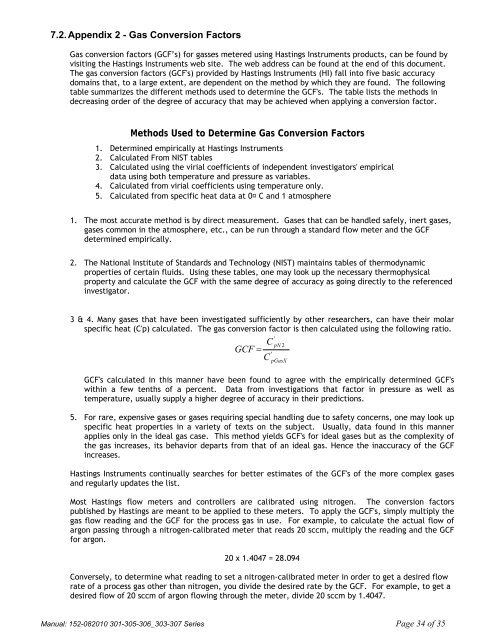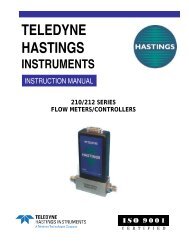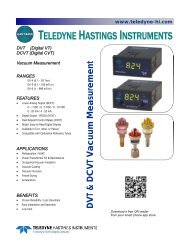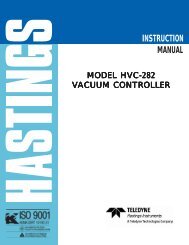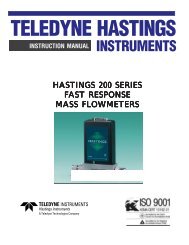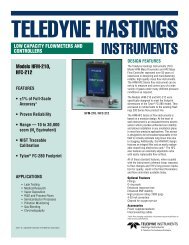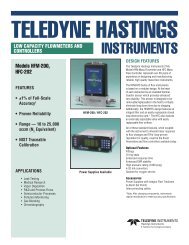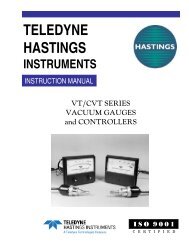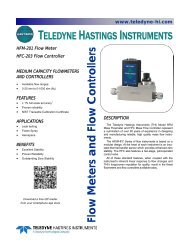HFM-301/305 HFC-303/307 - Teledyne Hastings Instruments
HFM-301/305 HFC-303/307 - Teledyne Hastings Instruments
HFM-301/305 HFC-303/307 - Teledyne Hastings Instruments
- No tags were found...
You also want an ePaper? Increase the reach of your titles
YUMPU automatically turns print PDFs into web optimized ePapers that Google loves.
7.2. Appendix 2 - Gas Conversion Factors<br />
Gas conversion factors (GCF’s) for gasses metered using <strong>Hastings</strong> <strong>Instruments</strong> products, can be found by<br />
visiting the <strong>Hastings</strong> <strong>Instruments</strong> web site. The web address can be found at the end of this document.<br />
The gas conversion factors (GCF's) provided by <strong>Hastings</strong> <strong>Instruments</strong> (HI) fall into five basic accuracy<br />
domains that, to a large extent, are dependent on the method by which they are found. The following<br />
table summarizes the different methods used to determine the GCF's. The table lists the methods in<br />
decreasing order of the degree of accuracy that may be achieved when applying a conversion factor.<br />
Methods Used to Determine Gas Conversion Factors<br />
1. Determined empirically at <strong>Hastings</strong> <strong>Instruments</strong><br />
2. Calculated From NIST tables<br />
3. Calculated using the virial coefficients of independent investigators' empirical<br />
data using both temperature and pressure as variables.<br />
4. Calculated from virial coefficients using temperature only.<br />
5. Calculated from specific heat data at 0 C and 1 atmosphere<br />
1. The most accurate method is by direct measurement. Gases that can be handled safely, inert gases,<br />
gases common in the atmosphere, etc., can be run through a standard flow meter and the GCF<br />
determined empirically.<br />
2. The National Institute of Standards and Technology (NIST) maintains tables of thermodynamic<br />
properties of certain fluids. Using these tables, one may look up the necessary thermophysical<br />
property and calculate the GCF with the same degree of accuracy as going directly to the referenced<br />
investigator.<br />
3 & 4. Many gases that have been investigated sufficiently by other researchers, can have their molar<br />
specific heat (C'p) calculated. The gas conversion factor is then calculated using the following ratio.<br />
C<br />
GCF =<br />
C<br />
'<br />
pN 2<br />
'<br />
pGasX<br />
GCF's calculated in this manner have been found to agree with the empirically determined GCF's<br />
within a few tenths of a percent. Data from investigations that factor in pressure as well as<br />
temperature, usually supply a higher degree of accuracy in their predictions.<br />
5. For rare, expensive gases or gases requiring special handling due to safety concerns, one may look up<br />
specific heat properties in a variety of texts on the subject. Usually, data found in this manner<br />
applies only in the ideal gas case. This method yields GCF's for ideal gases but as the complexity of<br />
the gas increases, its behavior departs from that of an ideal gas. Hence the inaccuracy of the GCF<br />
increases.<br />
<strong>Hastings</strong> <strong>Instruments</strong> continually searches for better estimates of the GCF's of the more complex gases<br />
and regularly updates the list.<br />
Most <strong>Hastings</strong> flow meters and controllers are calibrated using nitrogen. The conversion factors<br />
published by <strong>Hastings</strong> are meant to be applied to these meters. To apply the GCF's, simply multiply the<br />
gas flow reading and the GCF for the process gas in use. For example, to calculate the actual flow of<br />
argon passing through a nitrogen-calibrated meter that reads 20 sccm, multiply the reading and the GCF<br />
for argon.<br />
20 x 1.4047 = 28.094<br />
Conversely, to determine what reading to set a nitrogen-calibrated meter in order to get a desired flow<br />
rate of a process gas other than nitrogen, you divide the desired rate by the GCF. For example, to get a<br />
desired flow of 20 sccm of argon flowing through the meter, divide 20 sccm by 1.4047.<br />
Manual: 152-082010 <strong>301</strong>-<strong>305</strong>-306_<strong>303</strong>-<strong>307</strong> Series Page 34 of 35


